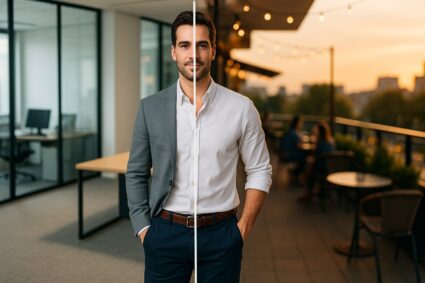What exactly is business casual?
While business casual can look different across companies and industries, the core principles stay consistent. You’re combining tailored pieces like modern fit chinos or dress pants with refined tops—think button-down shirts, knit polos, or lightweight sweaters. A blazer or sport coat elevates the look when needed, while leather shoes or clean sneakers ground the outfit. What qualifies: pressed chinos with a crisp button-down and loafers. What doesn’t: gym clothes, flip-flops, or overly wrinkled pieces.
The beauty of mens business casual attire lies in its flexibility. Tech companies might embrace chinos with polo shirts, while finance offices lean toward dress pants with blazers. The key is reading your workplace culture while maintaining those essential elements: well-fitted pieces in versatile colors, quality fabrics that move with you, and that confident, professional appearance that says you understand the dress code without overthinking it.
Business casual clothing for men
Business casual clothing for men centers on polished essentials that bridge the gap between formal and relaxed. The foundation starts with shirts. Think modern fit button-downs in breathable cotton or cotton-blend fabrics rather than stiff dress shirts. Knits like merino wool sweaters and polo shirts add versatility for layering or standalone wear.
Trousers should lean toward chinos in modern or slim fits, steering clear of overly casual denim or formal suit pants. Blazers elevate any look. Opt for unstructured styles in stretch fabrics that move with you. For footwear, leather loafers, clean sneakers, or casual oxfords work better than formal dress shoes or athletic trainers.
Smart accessories round out the look: leather belts, quality watches, and minimal jewelry keep things refined. Color palettes favor versatile neutrals. Midnight navy, charcoal, light sand, and crisp whites mix effortlessly. Patterns like subtle windowpane, classic plaid, or understated herringbone add interest without overwhelming. The key is choosing pieces that look intentional but not overly formal. Create outfits that transition seamlessly from morning meetings to after-work plans.
Business casual vs business professional
Business professional maintains strict formality with matching suits and limited color palettes, while business casual offers coordinated separates with room for personal expression. Business professional requires tailored suit jackets with matching trousers, formal dress shirts, and ties as standard. Business casual allows blazers or no jacket at all, paired with chinos or dress pants that don’t need to match your top layer.
The differences extend to every detail. Business professional demands formal dress shirts in classic colors, while business casual welcomes button-downs and quality polos in varied shades and subtle patterns. Footwear stays polished for both, but business casual offers more flexibility with loafers or clean leather sneakers alongside traditional dress shoes. Accessories tell the story clearly—ties are required for business professional but optional for business casual, where you can add personality through watches, belts, or pocket squares.
Choose business professional for formal presentations, board meetings, and traditional corporate environments where credibility demands maximum polish. Business casual works perfectly for regular office days, internal meetings, and most modern workplaces where you need to look sharp while staying approachable. The key principle: business professional prioritizes uniformity and tradition, while business casual balances professionalism with comfort and individual style.
How to dress in business casual
- Start with fit. Choose well-fitted trousers first. Modern fit chinos or dress pants that sit comfortably at your waist without bunching or pulling. The right fit makes everything else look more polished, regardless of price point.
- Select your shirt. Go for a button-down or polo in breathable cotton or cotton-blend fabric. Stick with classic colors like navy, white, or light blue that coordinate easily with your bottoms.
- Add a layer if needed. A lightweight sweater, cardigan, or unstructured blazer in neutral tones elevates your look instantly. Choose fabrics like merino wool or cotton blends that move with you throughout the day.
- Choose appropriate footwear. Leather loafers, clean sneakers, or dress shoes in brown or black work well. Make sure they’re in good condition. Scuffed shoes can undermine an otherwise sharp outfit.
- Finish with subtle details. A leather belt that matches your shoes, a simple watch, or a pocket square adds personality without overdoing it. Keep accessories minimal and functional.
Remember, business casual varies by company culture, so observe your workplace norms and adjust accordingly. The goal is looking put-together while feeling comfortable enough to focus on your work.
When to wear business casual attire
Business casual hits that sweet spot when you need to look polished without the full formal treatment. It’s your go-to when the situation calls for professional credibility with a dose of approachability.
- Regular office days , Most modern workplaces where you’re interacting with colleagues and need to look put-together
- Client meetings , When you’re building relationships but the setting isn’t boardroom-formal
- Industry conferences , Professional events where you want to network confidently without overdressing
- Job interviews at relaxed companies , Tech firms, creative agencies, or startups where a suit might feel out of place
- Lunch meetings , Business discussions in casual restaurant settings
- Team presentations , When you’re speaking to groups but want to stay approachable
Quick decision test: If you’re unsure, consider your audience and environment. Are you the most dressed-up person in the room? You might be overdoing it. Are you representing your company to external contacts? Business casual keeps you looking professional while staying relatable. When in doubt, it’s better to be slightly more polished than underdressed.
Essential Business Casual Wardrobe for Men
Building a versatile business casual wardrobe is all about combining professional polish with everyday comfort. Here are the fundamental pieces every man should consider, along with practical tips to get the most from each item:
- Tailored Shirts: Opt for modern or slim-fit button-down shirts in crisp white, light blue, or subtle patterns. Cotton or performance blends that resist wrinkles are ideal for long days at the office. Polo shirts in refined fabrics like pima cotton or merino wool blends (classic navy, charcoal, or white) also bridge the gap between casual and professional.
- Chinos & Trousers: Choose chinos in versatile shades like navy, charcoal, or khaki, made from stretch cotton blends for comfort and shape retention. Dress pants in wool blends and modern-fit khakis can elevate your look. Fit tip: Modern fits look sharp while allowing easy movement.
- Knit Layers: Lightweight crew neck or V-neck sweaters, cardigans, and quarter-zip pullovers in merino wool or cotton-cashmere blends make excellent layering pieces. They are perfect for fluctuating office temperatures and seasonal changes.
- Unstructured Blazer: A stretch wool or cotton-linen blend blazer in classic navy or charcoal instantly upgrades any outfit. Look for unstructured, comfortable fits that are easy to layer and move in. Fit tip: Prioritize a proper fit in the shoulders; everything else can be tailored.
- Footwear: Leather dress shoes (oxfords, derbies, or loafers) in brown or black are versatile choices that suit both chinos and dress pants. Clean leather sneakers or suede loafers can add a modern, relaxed edge. Polish tip: Well-maintained shoes always enhance your look.
- Quality Leather Belt: Pick a classic-width brown or black leather belt that matches your shoes. This simple accessory pulls your outfit together for a cohesive, polished appearance. Shop top picks.
With these essentials, you can create a wide range of business casual outfits that balance style, comfort, and professionalism—perfectly suiting the evolving office dress code and keeping you confident through any workday.
Dos and don’ts
Business casual means balancing professionalism and comfort. Follow these tips to look confident at work:
- Do: Wear well-fitted, comfortable clothes in versatile colors like navy and charcoal.
- Do: Keep grooming neat and layer smartly with blazers or cardigans.
- Do: Choose clean leather shoes or simple sneakers if appropriate.
- Don’t: Wear wrinkled, ill-fitting, or gym clothes. Avoid excessive patterns and always consider the occasion.
When unsure, it’s safer to be slightly overdressed for a polished, confident impression. Common missteps include poor fit, neglected grooming, and inappropriate shoes. Opt for modern fits, keep shirts and shoes clean, and dress for your office’s culture. Limit bold patterns and retire worn pieces. On video calls, maintain professional standards—even on camera.
Business casual vs smart casual
Business casual is for professional settings—think tailored shirts, chinos, and loafers. Smart casual is more relaxed, featuring dark jeans, polos, and clean sneakers. Choose business casual for the workplace and smart casual for social or informal events.
Business casual prioritizes work-appropriate, structured outfits, while smart casual emphasizes personal style and comfort. Match your choice to the setting.
Modern workplace dress codes
Today’s workplace dress codes have evolved to balance professionalism with comfort and personal style. Here’s how the current standards break down:
- Business professional: The most formal office attire. Think tailored suits, dress shirts, and polished leather shoes. Perfect for client presentations, board meetings, or traditional corporate environments where first impressions matter most.
- Business casual: Professional yet relaxed, blending button-down shirts, chinos, and blazers without requiring a full suit. Ideal for typical office days, team meetings, and most modern workplace settings where you need to look polished but approachable.
- Smart casual: Elevated everyday pieces that look intentional. Like a well-fitted polo, dark jeans, or knit sweater paired with clean sneakers or loafers. Great for creative industries, casual Fridays, or networking events with a relaxed vibe.
- Casual: Comfortable, clean, and put-together without formal structure. Think well-fitted t-shirts, casual pants, and comfortable footwear. Best for startups, remote work video calls, or company social events where the focus is on comfort and authenticity.
The key is reading your company’s culture and adapting accordingly. When in doubt, it’s always better to be slightly overdressed than underdressed.
Can you wear jeans for business casual?
It depends on your workplace culture and the style of jeans you choose. Dark-wash, well-fitted jeans without distressing can work in relaxed business casual environments, especially in tech and creative companies. The key is choosing jeans that look intentional and polished rather than weekend casual.
What doesn’t work: light wash, ripped, or overly casual denim. If you’re unsure, choose chinos—they’re always appropriate for business casual. Even in jeans-friendly offices, important meetings or client interactions may call for traditional trousers. Observe what leadership and colleagues wear, and when in doubt, opt for one level more polished. Business casual varies significantly by setting, so reading your specific workplace culture is essential.
What shoes are appropriate for business casual?
Business casual footwear strikes the perfect balance between professional polish and everyday comfort. Your best choices include leather dress shoes like oxfords and derbies, classic loafers, suede loafers, and clean leather sneakers in conservative colors like brown, black, or navy. Ankle boots work well too, especially during cooler months.
Here’s what doesn’t work: athletic sneakers, flip-flops, sandals, or heavily worn shoes. Even appropriate styles fail if they’re scuffed or poorly maintained—shoe condition matters as much as style. For color coordination, match your shoe color with your belt, choose brown shoes for most business casual combinations, and pair black shoes with charcoal and navy trousers. When deciding between dress shoes and casual alternatives, consider your day’s agenda. Client presentations call for polished leather shoes, while internal meetings allow more flexibility with clean sneakers or suede loafers.
Is a tie required for business casual?
Ties are generally not required for business casual attire—a key difference from business professional dress codes. Business casual encourages a more relaxed yet polished look, typically featuring well-fitted button-down shirts or quality polo shirts worn without ties. This reflects the modern shift in many workplaces away from formal neckwear. However, conservative industries such as traditional banking or certain law firms may still expect ties even in business casual settings, and important meetings or formal presentations could occasionally call for a tie. When in doubt about the level of formality needed, it’s wise to bring a tie along for added flexibility. In most standard business casual environments, however, forgoing a tie is appropriate and expected.
How formal is business casual compared to other dress codes?
Business casual occupies the middle ground on the workplace dress code spectrum. At the most formal end is business formal, requiring full suits and ties; business professional usually means suits or blazers, with or without ties. Business casual uses coordinated separates—like dress shirts, dress pants, or chinos—without a suit or tie, striking a balance between structured business attire and the ease of smart casual, which features elevated everyday pieces. Casual dress codes, by comparison, allow for the most relaxed clothing.
Ultimately, business casual stands out for offering a polished, professional impression without the rigidity of traditional business wear. The right choices depend on your industry, company culture, and occasion—tech workplaces tend to be more relaxed, while finance or legal environments may still favor a more structured look. The flexibility of business casual allows you to maintain professionalism suited to your work environment.
Business casual by industry
Business casual looks different across industries, shaped by company culture and varying expectations. The overall principle is to maintain a professional yet comfortable appearance, but specific guidelines can differ significantly.
- Tech: Often the most relaxed, with modern-fit chinos or jeans, polos or button-downs, and clean sneakers or loafers. Functionality and comfort are prioritized, and layering is minimal. Startups may even welcome hoodies and well-fitted t-shirts under blazers.
- Finance: More structured and traditional. Expect tailored trousers, pressed button-downs, and leather dress shoes. Blazers or sport coats are common, especially in client-facing roles, and colors tend to be conservative—navy, charcoal, or classic patterns. Some companies or roles may require ties for specific meetings.
- Creative: Emphasizes self-expression and individuality within professional limits. Well-fitted, contemporary pieces, textured blazers, or patterned shirts are common, along with unique accessories like statement watches or socks. The focus is on intentional combinations that balance style and credibility.
- Education: Strikes a middle ground. Approachable professionalism is key—think khakis or dress pants with button-downs, polos, or sweaters—balancing authority with classroom accessibility.
Remember, these are general tendencies—individual companies may dress more or less formally than their industry norm. A startup in finance might favor a tech-style look, while an established creative agency may require more polish. When in doubt, observe your workplace for a few days or ask HR for guidance, as company culture often trumps industry stereotypes.






